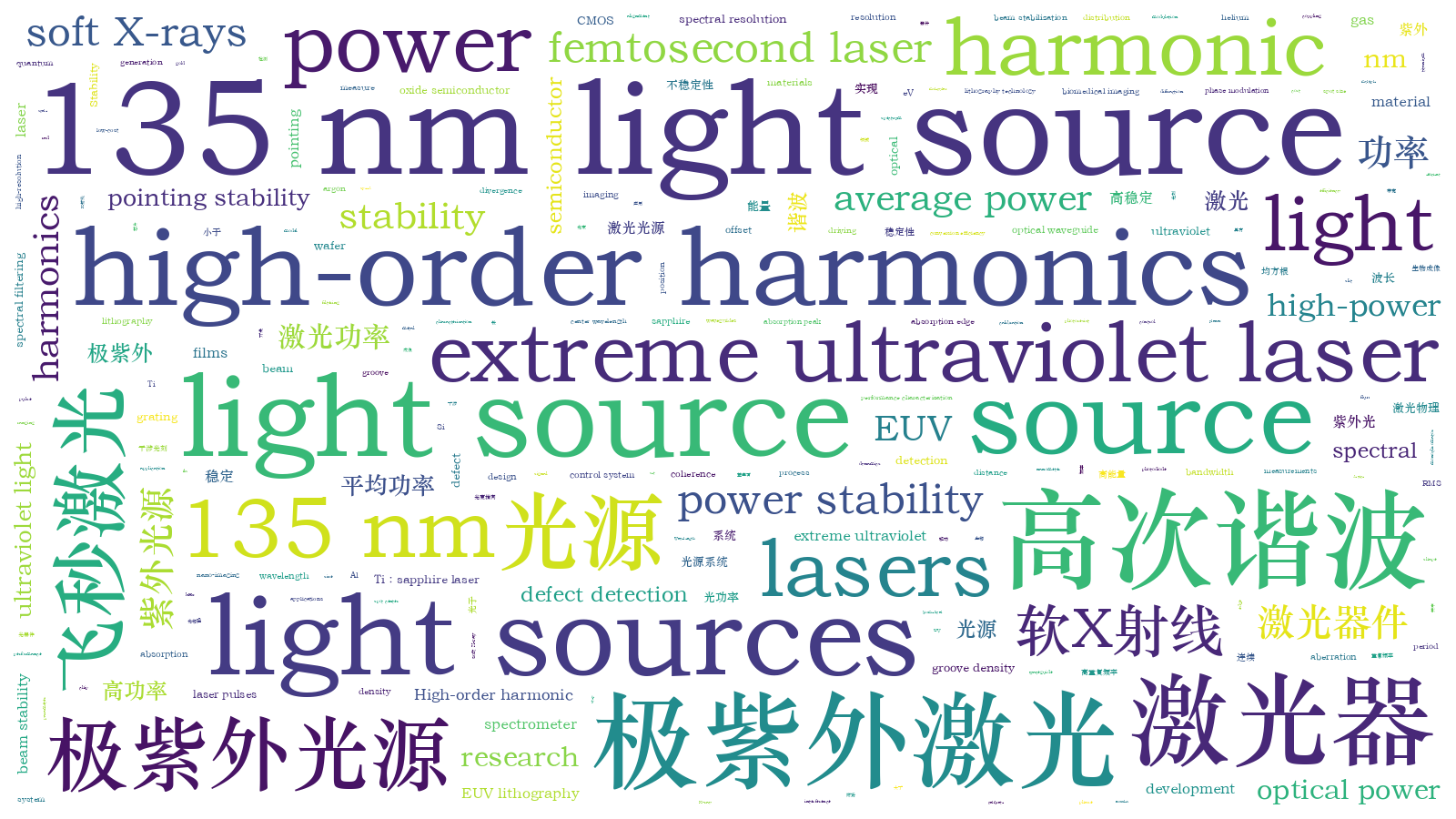基于高次谐波的高功率高稳定13.5 nm极紫外光源封面文章【增强内容出版】
Short wavelength, short-pulse, and high-coherence laser sources are urgently needed for research on ultra-wide dynamics at the microscopic scale. Additionally, with the demand for an ever- increasing chip computing speed, the semiconductor field urgently requires small and low-cost extreme ultraviolet light sources for material development and wafer defect detection. High-order harmonic (HHG) technology is used to realize laboratory desktop applications and produce high-coherence and high-resolution extreme ultraviolet (EUV) light sources, which is one of the most reliable technologies and is gradually becoming one of the most important tools for atomic, molecular, advanced quantum, and other materials research as well as nano-imaging. Based on the semiconductor field and experimental requirements, we build a set of HHG-EUV sources using a commercial Ti∶sapphire laser, which is a highly stable, high-power 13.5-nm source. This will advance research in material development, semiconductor performance characterization, biomedical imaging, wafer defect detection, and other fields of research.
High-order harmonic processes can be explained by the semiclassical three-step model, and several experiments have demonstrated that Ti∶sapphire lasers are among the best driving sources for generating an EUV source. Focused high-average-power laser pulses interacting with rare gases produce harmonics that cover the extreme ultraviolet(UV)and soft X-ray regions, thereby making them the most efficient source for electrodynamics studies. The reaction region is commonly characterized using nozzles, gas cells, and hollow waveguides. The latter has the highest harmonic conversion efficiency owing to the phase modulation process; however, it is difficult to calibrate and achieve a stable output over long periods. To achieve a high flux and stable output from a 13.5-nm harmonic source, we design and build a beam stabilization control system to assist the alignment process and maintain beam stability. In addition, we build a dual-optical and flat-field spectrometer that can effectively optimize the harmonic aberration in the harmonics generated by the device.
When helium is used as the generation gas, the spectral distribution around 13.46 nm is filtered with Zr films. A calibrated photodiode is used to measure the optical power signal, and the total power generated by the light source is calculated as approximately 1.9 μW. The spot shape is captured using complementary metal-oxide semiconductor (CMOS) at a distance of 1.9 m from the light source [Fig.2(b)], and the 1/e2 spot size is calculated to be 1.92 mm×1.67 mm with the x-divergence full-angle of the spot calculated to be 1.01 mrad, and the y-divergence full-angle of the spot calculated to be 0.88 mrad. When argon is used as the generation gas, two 250-nm thick Al films are used for spectral filtering, and the spectral distribution is around 30 nm. The calculated average power is 120 μW at the light source. Furthermore, in order to measure the pointing and power stability of the EUV beams, a CMOS is placed at a distance of 1.9 m from the light source. The root-mean-square (RMS) of the pointing stability is then calculated using the offset of the spot center from the initial position over a 12-h period, with the pointing offset of the beam in the x-direction controlled to within 6.3 μrad and that in the y-direction controlled to within 7.2 μrad. The average RMS power stability over a 12-h period is 4.37%.
Wavelength calibration is performed using an in-house-designed dual-optics flat-field spectrometer with Al and Si films, as shown in Fig.4(b), which demonstrates the filtered HHG spectral signals of the different films collected using a grating with groove density of 500 line/mm. With the help of the steep absorption edge of the Si film at approximately 12.5 nm (the absorption peak of the Ai film is at approximately 17.05 nm), the position of the 59th harmonic peak at 13.46 nm is obtained. Combined with the slit, our flat-field spectrometer can output any chosen harmonic that minimizes the aberration. As shown in Fig.6, we analyze the first-, second-, and third-order diffraction harmonic intensities of the grating acquired by CMOS, which are consistent with the results of the theoretical coupling calculations. We significantly improve the harmonic spectral resolution using a gold-plated planar grating with groove density of 1200 line/mm. We determine that the 13.46-nm harmonic contains an average power of about 0.32 μW, and that its true bandwidth is less than 0.124 nm.
A high-power, high-stability HHG source with a spectrum ranging from 10 nm to 40 nm is developed based on an inflatable hollow optical waveguide using a titanium gemstone laser as the driving light source. Using helium or argon as the reaction gas, multiple harmonics covering 10 nm to 40 nm are obtained, and the total power can be as high as 120 μW. Combined with an in-house designed dual-optics flat-field spectrometer and a monochromator, a single harmonic with an average power of about 0.32 μW, a bandwidth of about 0.124 nm and a center wavelength of 13.46 nm is obtained. The engineering design is adopted for the system and a technical breakthrough for this type of light source in terms of the pointing stability and power stability index is therefore successfully realized, which are world-leading results. Our study lays a solid foundation for the application and promotion of this light source in the industry. This light source will be popularized and validated in the fields of EUV interference lithography experiments, photoresist research and development, material parameter measurements in EUV lithography technology, nanometer or quantum material research and development, and semiconductor wafer defect detection.
李逵, 孟润宇, 李睿晅, 张光银, 姚铭杰, 徐豪, 王雨童, 李捷, 张晓世, 樊仲维. 基于高次谐波的高功率高稳定13.5 nm极紫外光源[J]. 中国激光, 2024, 51(7): 0701011. Kui Li, Runyu Meng, Ruixuan Li, Guangyin Zhang, Mingjie Yao, Hao Xu, Yutong Wang, Jie Li, Xiaoshi Zhang, Zhongwei Fan. High Power and High Stability 13.5 nm Extreme Ultraviolet Light Source Driven by High‑Order Harmonics[J]. Chinese Journal of Lasers, 2024, 51(7): 0701011.







